Like most rocky headlands that jut into the ocean, Mori Point in Pacifica seems to have an irreducible bit of wildness in it. Perhaps it’s the topography: treeless heights that end abruptly in cliffs that drop into the ocean, waves crashing at their feet. Or the windblown terraces covered each spring in tidytips, goldfields, and lupine that cause one botanist to call this a “wildflower mecca” unlike any other along this stretch of coast.
Come in spring, look up from the wildflowers, and you might see gray whales spouting just offshore on their way north. Or even, as local resident Paul Jones reported in summer 2008, a pair of humpback whales lunge-feeding–two enormous animals erupting out of the water, mouths agape, devouring a school of fish only 200 yards from the beach.
Then again, from almost anywhere in the park, you’ll see the manicured greens of Sharp Park Golf Course and the rows of houses in the subdivision to the north, or the hotels and businesses of Rockaway Beach to the south.
Mori Point is hemmed in by humanity. Or embraced by it, depending on your point of view.
- The San Francisco garter snake, with its distinctive blue and red stripes, is one of the most endangered reptiles in North America. Photo by Frank S. Balthis.
It’s not just the whales or the ocean views that have motivated locals to preserve and restore this landscape. The key has been the presence of two special-status species: the threatened California red-legged frog and the critically endangered San Francisco garter snake, arguably the most endangered snake in North America. The San Francisco forktail damselfly, rare though unlisted, also lives near the same wetlands so important to the frog and snake.

- The threatened California red-legged frog is the snake’s main food, and restoration here aims to help the snake by increasing habitat for the frogs. Photo by Ryan Jones, courtesy Golden Gate National Parks Conservancy.
The fate of these species has helped dictate activities on the approximately 200 acres of open space around the point. On the north side, adjacent to Sharp Park, the Golden Gate National Recreation Area (GGNRA) manages 110 acres, including the point itself.
A Florida-based developer owns much of the remaining open space on the south side of the point, where steep hills plunge into a former quarry and then to Calera Creek. The developer, R. Don Peebles, lost a public vote to allow construction on the site in 2006.
Active local support has been the driving force for preservation here, from the purchase of the land in 2000 by the Trust for Public Land to today’s remarkable restoration program run by the Golden Gate National Parks Conservancy.
Paul Jones, who once sat on the board of the Pacifica Land Trust and currently serves on the local GGNRA advisory committee, has watched public support for preserving the point grow exponentially since he moved here in 1980. “I used to go birding out there pretty frequently, and I’ve watched it go from being a rundown ramshackle remnant of Mori’s Point Inn to what it is today,” he says. “The sense of citizen ownership and the outpouring of support on workdays have been wonderful to see.”
That gets at the central tenet of the Parks Conservancy’s work, says Site Stewardship Director Sue Gardner. “We believe that sensitive species and people can coexist, given the right mix of education, community support, and creative design. The presence of an endangered species doesn’t necessarily mean that visitor access needs to be restricted. At Mori Point, it’s been just the opposite,” she says. “Engaging people and increasing awareness helps individuals understand, appreciate, and ultimately take care of these species.”
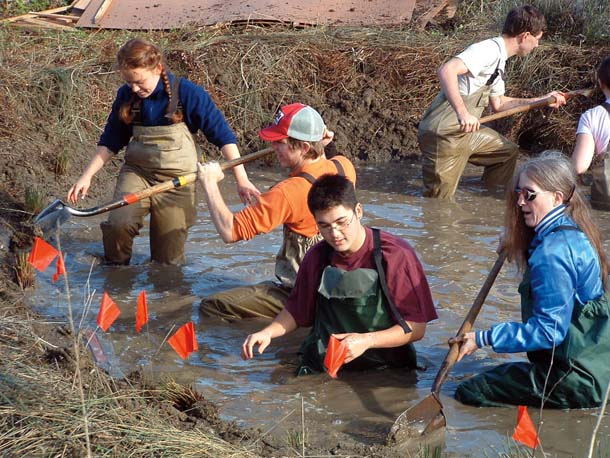
- Volunteers help plant natives in a new pond built by the Golden Gate National Parks Conservancy’s Site Stewardship Program. The ponds are prime habitat for California red-legged frogs. Photo by Ryan Jones, courtesy Golden Gate National Parks Conservancy.
The health of the frogs is key for both frog and snake, since the frogs make up most of the snakes’ diet. While California red-legged frog restoration projects seem to pop up wherever wetlands and ponds can be restored, the range of the garter snake is limited almost entirely to San Mateo County.
The snakes at Mori are crucial to the survival of the species. Karen Swaim, an authority on Bay Area snakes who has consulted for GGNRA and other parties around Mori Point, says the snakes here make up the subspecies’ northernmost population and their color patterns are similar to the original specimens that defined the subspecies, perhaps because they have hybridized less with other kinds of garter snakes.

- Horse Stable Pond, wedged between the uplands at Mori Point and the Sharp Park Golf Course, is a remnant of a much larger wetland that once connected with Laguna Salada to the north. Photo (c) Dan Suzio, www.dansuzio.com.
Restoration at Mori has been squarely aimed at creating and enhancing the mix of wetlands and uplands the snakes and frogs need. The most obvious improvement is the creation of several ponds, fenced from dogs and stocked with native marsh plants. Frogs have bred in all the ponds, and Swaim and her staff have documented increased use by the snakes as well.
The restoration work has also included closing many of the informal trails that developed over the years and adding new trail segments to improve overall flow and access. Local historian and trail volunteer Jerry Crow estimates that about 80 percent of the old trails have been closed. Most are now straw-covered warrens of plastic flags, each marking a small native plant seedling doing its part to revegetate the landscape.
You might think shutting down trails would ruffle feathers among park visitors, but that does not seem to have happened here. “[Parks Conservancy staff] have done such a fantastic job educating the public,” says Swaim. “They have gone out of their way to make sure everything they are doing is going to favor these species.”
One Saturday in December was typical: Several dozen students from City College and a nearby high school were joined by a few locals who often pitch in. Restoration manager Christina Crooker says volunteers can plant as many as 500 plants on a good day. Not bad when your goal for the winter planting season is 20,000 stems in the ground. Many of those seedlings are grown at a nursery the conservancy operates, with student help, at Pacifica’s Oceana High School.
Public support for saving Mori Point has roots beyond the current work, and nothing illustrates that more clearly than the story of how San Francisco-based Trust for Public Land (TPL) bought the property and transferred it to the GGNRA.
In the late 1990s, a local developer who owned the point went bankrupt and was forced to sell the land at auction to the highest bidder. “When local people realized that it was going to be sold at an auction, we leaped into action,” says Mike Vasey, a San Francisco State University botanist and member of the Pacifica Land Trust board.
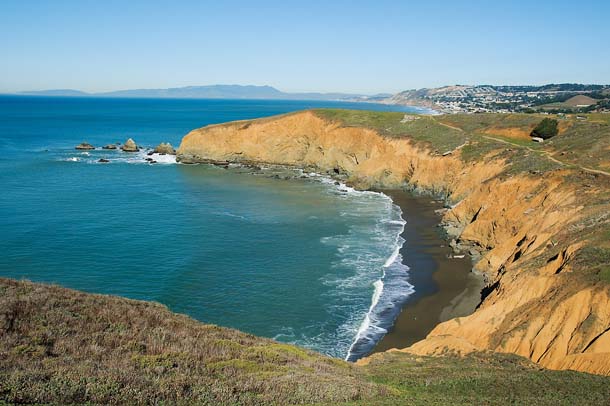
- Mori Point with parts of Daly City and Pacifica beyond. Mount Tamalpais is clearly visible to the north. The point itself was protected in 2000, but the southern portion of the open space, from which this photo was taken, remains in private hands Photo (c) Dan Suzio, www.dansuzio.com.
The minimum bid was $2.5 million, and you couldn’t get into the auction room without a bank check for $100,000. TPL managed to get a no-interest loan to cover the $2.5 million minimum bid, along with $1 million from the Coastal Conservancy for the purchase, but the local land trust had to come up with the cash for the bank check.
“We have never had anything like it before or since,” says Vasey. “We had to do it in less than a month, and we pulled it off.”
TPL’s Tim Wirth remembers a white-knuckle day at the auction house in September 2000. He held off as others bid up the price until he stepped in with what was both his first and his maximum bid: $3.3 million. “We made one bid, the all-important final bid.” He couldn’t have gone any higher, but fortunately, the other bidders dropped out, so TPL closed the deal. In 2002, the land was transferred to the GGNRA, and the Parks Conservancy was able to quickly take over and start managing the land and restoring habitat.
But that’s not the end of the struggle for protection here. I walked the land with Vasey one sunny winter day, and he took me in from the south, across Calera Creek and through the pampas-infested former limestone quarry that slices into the steep, eroding slopes overlooking Rockaway Beach.
Vasey, in full professor mode, could reel off the Latin names for each plant we walked past. But he also thinks big, in terms of whole ecosystems. At Mori, he says, even the great work being done by Gardner and her volunteers is limited somewhat because they’re able to work on only half the system.
The other half remains in limbo, held by Peebles, who has lobbied for permission to build on the land, so far unsuccessfully.
In the meantime, the land just sits.
That’s better than what happened under the quarry’s previous owner, who illegally filled ponds and destroyed wetlands. The fines for those violations eventually helped pay for restoration of Calera Creek, which is now a healthy-looking riparian corridor linked to the GGNRA parcel by a low saddle that should allow for passage of snakes and frogs. Herpetologist Sean Barry recorded snakes on the saddle in the 1970s, though Swaim says no one has seen any there recently.
In a cruel twist of fate, a population of the rare variable linanthus (Leptosiphon rosaceus), a small annual plant, clings to an eroding cliff on the wrong side of the GGNRA border. Vasey would like to see seed from this population collected, multiplied in a nursery, and then planted back out in the wild. “It would make sense not to wait forever,” he adds. “One good storm and that whole population could be gone.”
Winter storms can erase a lot here. Jerry Crow, a retired engineer now active in the Pacifica Historical Society, took me to the spot where Mori’s Point Inn used to stand. There’s almost nothing left of the inn, which burned in 1966. And there’s even less of the large parking lot that once sat to the west of the inn. That land is gone entirely, devoured by the hungry Pacific.
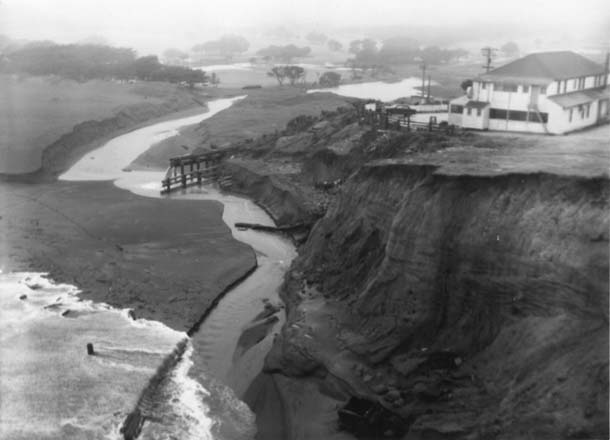
- Mori’s Point Inn was perched above the waves for decades until it burned in 1966. Today, the freshwater outlet visible here has been closed off by a levee, and almost all traces of the inn are gone. Photo courtesy GGNPC.
The inn was a popular destination until its ignominious end in 1965, after the local health department condemned the property and took its recalcitrant manager, Doug Hart, away in handcuffs.
Stefano Mori bought land here in the 1880s, kept cattle and sheep, and grew artichokes and Brussels sprouts. A kitchen meant for ranch hands grew into the inn. His sons, Jack and Ray, eventually took over the operation.
Jack turned into a notorious rumrunner during Prohibition. Crow, with an engineer’s affection for clever devices, describes the tramway that Jack rigged up for unloading Canadian boats offshore, beyond the steep cliffs. The system worked pretty well until federal agents caught Jack with 24,000 cases of whiskey at the family farm.
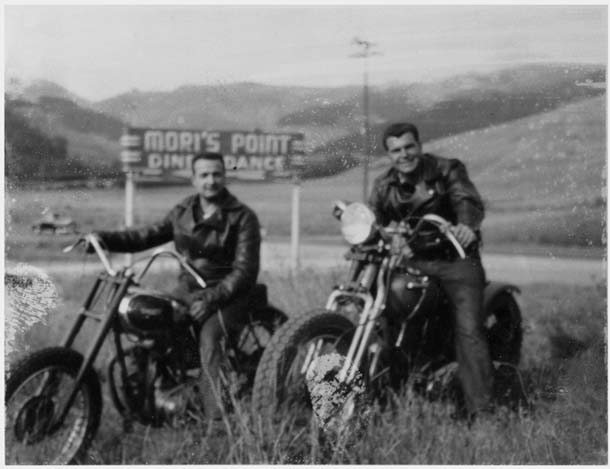
- Motorcyclists Richard Hall (left) and Fred Girdler (right) along Highway 1 in the mid-1950s. Photo courtesy GGNPC.
As late as the 1950s, this part of the coast could feel pretty isolated. Vincent Lorrain, who now lives in Tucson, grew up coming out to Mori’s Point Inn just about every Sunday. His grandmother, Marie Mori Jones, owned and operated the inn after her husband, Ray, died.
Back then, the long trip over winding roads from Burlingame made this a world apart. “If you were going to live on the coast at that time,” Lorrain says, “you had to be a hardy person to buck those roads. They weren’t pouring martinis over the bar. It was bourbon and scotch.”
After the inn shut down, sand quarrying and off-road motorcycling left their scars on the landscape. But the ongoing restoration, along with inevitable erosion, will eventually erase those marks as well.
It’s less clear what will happen to the Sharp Park Golf Course and the wetlands at Laguna Salada and Horse Stable Pond. The course, contiguous with GGNRA’s land, is owned and operated by the City of San Francisco, which is in the midst of determining the future of all its golf courses.
“There is immense opportunity to do tremendous good here,” says Brent Plater, a lawyer and environmental activist who serves on the city’s Golf Course Task Force. “This area could be linked together for natural recreational uses. That is the best vision for that landscape, especially with the long-term habitat restoration at Mori Point.”
That idea doesn’t sit well with some, like Jerry Crow, who say the Sharp Park course is a critical recreational draw for Pacifica. Plater says his goal is to shift the focus from golf to natural habitats and restoration work, even if some limited golf operation remains on site.
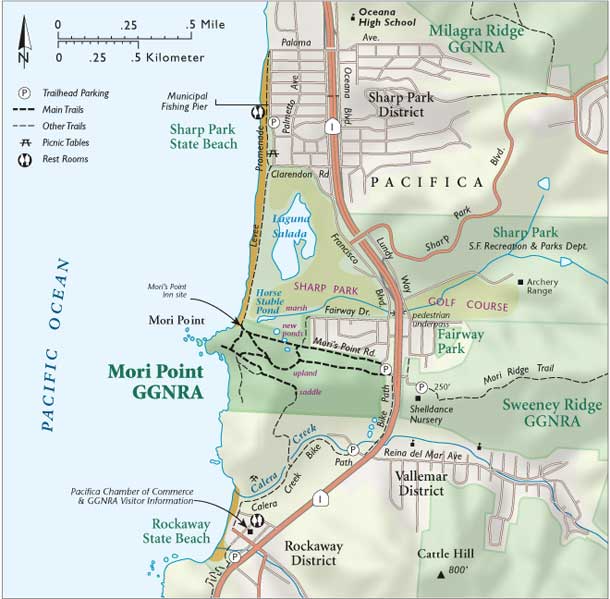
- Click map for larger version. Map by Ben Pease, www.peasepress.com.
Vasey is excited at the prospect: “This used to be an extension of the San Francisco dune ecosystem. There’s hardly any of that dune flora left. It would be wonderful to restore a marsh-lagoon-dune ecosystem.”
For Vasey, whatever happens to the golf course, a future with sound management on the south side and habitat restoration on the north would bode well for Mori Point at the heart of it all. But that will be years in coming.
Meanwhile, Mori Point hums with life, from the damselflies to the frogs that hunt them and the snakes that hunt them in turn. All watched over by a growing network of biologists, land managers, and, most important, neighbors and other regular folks who keep going out of their way to look off into the wild Pacific, and then pick up a shovel for the sake of a frog and a snake.
Getting There
From north or south, take Interstate 280 to Highway 1 south. From Highway 1 south, turn right on Mori Point Road, which dead-ends at the trailhead. Park along the road. SamTrans buses 110 and 112 stop near the park. There’s a pit toilet but no other facilities. Dogs must be on leash.

.jpg)
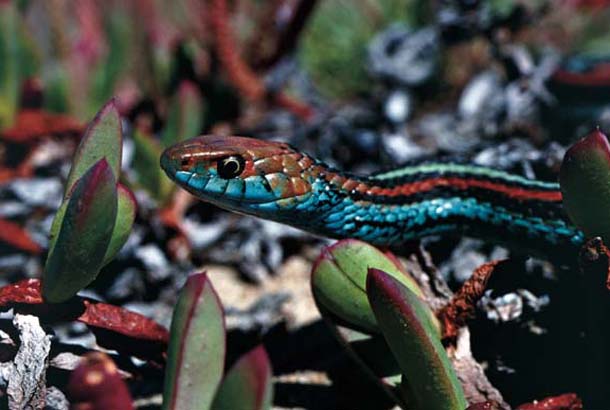
-300x189.jpg)